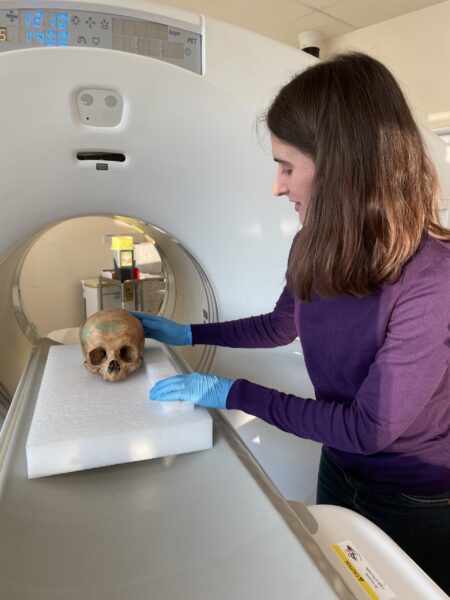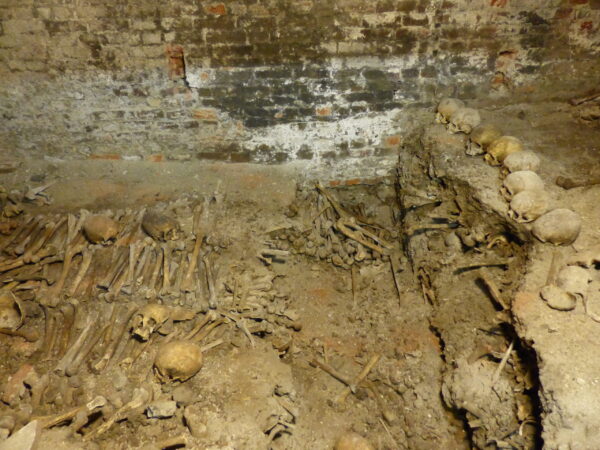Katherine Van Schaik, MD, PhD, MA, is a time traveler.
A fellow in radiology at Vanderbilt University Medical Center (VUMC), Van Schaik (pronounced Shake) is as comfortable translating texts from ancient Greek into English and scanning the mottled skulls of 18th-century sailors, as she is interpreting imaging studies of her patients.
For Van Schaik, who earned a doctorate in ancient history from Harvard, the past holds important clues for improving health today. That is why this modern-day Renaissance woman has come to VUMC, to pursue research on longevity, skeletal health and the intersections between the skeleton and immune system.
Her husband, James Zainaldin, PhD, is an assistant professor of Classical and Mediterranean Studies at Vanderbilt University. They arrived in Nashville in mid-2023 with their 2-year-old son after Van Schaik completed her residency at Harvard University, where she also earned her bachelor’s and medical degrees.
Of the Vanderbilt community, she said, “It’s rigorous. It’s warm. It’s collegial. It’s internationally recognized. It’s interdisciplinary. It really is everything that we were hoping and dreaming to find as a place to land early in our careers and … build a research program.”
Whole-body CT imaging of mummies from four genetically distinct populations, and from four different time periods, has revealed arterial calcification, a tell-tale sign of atherosclerosis, which was thought to be the exclusive manifestation of the modern lifestyle.
Recruited by Dan Brown, MD, interim chair and professor of Radiology and Radiological Sciences, Van Schaik said a big draw was the chance to work with James Crowe Jr., MD, whose broad-ranging explorations of human immunity have included the isolation of antibodies from survivors of the 1918 flu pandemic.
With Crowe, the Ann Scott Carell Chair, University Distinguished Professor of Pediatrics, and director of the Vanderbilt Vaccine Center, she has begun a collaboration with leading investigators in Europe to study ancient human immune responses in historical tissue and archeological specimens, with correlations to imaging findings.
Although the viruses that triggered ancient immune responses no longer exist, “if you could reconstruct what an immune response might have looked like to a pathogen so deadly that it just about killed everyone … those findings could help inform prevention against future outbreaks,” Van Schaik said.
Examining a skeleton with the help of imaging could yield clues about the physiological stresses that someone endured over his or her lifetime and enhance data about that individual’s immune response. “This work could provide information that is completely outside our own time and world,” she added. “It’s time travel.”

Van Schaik, who is proficient in Latin and Greek, has been fascinated with the ancient world since she was in middle school in Columbia, South Carolina, where she grew up. Her translation of the second-century Greek physician, Galen, entitled How to Be Healthy: An Ancient Guide to Wellness, was published in January by Princeton University Press.
As a Harvard undergraduate, Van Schaik pursued a dual degree in Classics and Molecular and Cellular Biology. At her graduation in 2008, she delivered Harvard’s traditional Commencement address entirely in Latin. She later earned a master’s degree in Classical Art and Archaeology at King’s College London.
At Harvard Van Schaik discovered the field of bioarchaeology, the study of old bones and preserved soft tissues, which has upended long-standing assumptions about ancient life.
For example, whole-body computerized tomographic (CT) imaging of mummies from four genetically distinct populations, and from four different time periods, has revealed arterial calcification, a tell-tale sign of atherosclerosis, which was thought to be the exclusive manifestation of the modern lifestyle.
In 2016, while pursuing her medical degree and PhD, Van Schaik and a forensic radiology colleague used a portable X-ray machine to examine a collection of 18th– and 19th-century human skeletons interred in the crypt of St. Bride’s Church in London.
Osteological (manual examination) and radiological analyses of the bones, which are in the curatorial care of the Museum of London’s Center for Human Bioarchaeology, revealed that both analyses are crucial for a detailed understanding of health and disease in long-deceased individuals.
Training in radiology is essential for these analyses, Van Schaik said. Molecular analyses, such as those that she and Crowe are pursuing, can shed even more light onto previously darkened corners in the history of human health and disease.
She and her colleagues are conducting CT and DNA analyses in two modern cohorts, and in a group of 15 British sailors from the 19th century who experienced significant skeletal trauma, including multiple healed fractures.
In 2021, during her residency training in radiology at Harvard, Van Schaik added another tool to her investigations of ancient health and disease—epigenetics, the study of environmentally-driven modifications in gene expression that are not due to mutations in the DNA.
Turns out that bones and teeth provide an excellent time capsule for preserving one’s DNA, as well as the methylation patterns in the genetic code that reflect changes in gene expression.
Thus, DNA extracted from bones and teeth, even those that are centuries old, can provide a window into which genes were turned on, and which were turned off, in response to various environmental exposures.
Van Schaik is principal investigator of a grant from the National Science Foundation to investigate the relationship between bone injury and epigenetic modifications associated with osteoporosis, a disease primarily of aging that causes bones to become weak and brittle.
With additional funding from the Archaeological Institute of America and the Society of Antiquaries of London, she and her colleagues are conducting CT and DNA analyses in two modern cohorts, and in a group of 15 British sailors from the 19th century who experienced significant skeletal trauma, including multiple healed fractures.
The sailors lived into their 60s despite the extensive traumatic injuries they endured. “So, they were hardy!” Van Schaik said. “If any individual’s remains would show evidence of epigenetic modification, it would probably be these gentlemen.”

Van Schaik’s co-principal investigators are her mentor from Harvard, Jim Wu, MD, a musculoskeletal radiologist, Hendrik Poinair, PhD, a molecular biologist/anthropologist from McMaster University, and Jane Buikstra, PhD, a bioarchaeologist from Arizona State University. The multicenter project also involves investigators from VUMC, the University of New Mexico, and United Kingdom.
Epigenetics is “an exciting bridge between our genetic code and the remarkable variability in genetic expression,” Van Schaik said. “People can have similar genetic profiles related to a disease yet manifest that disease very differently. Epigenetics can help to explain … why certain people are more affected than others.”
Van Schaik said her research has been guided by two questions: How is disease defined, and how has that definition changed over time?
“Our definitions (of disease) … are products of the world in which we live, and the evidence that we have,” she said. “Available evidence and how we interpret it changes over time. We are not always aware … of what we’re overlooking as we frame our research questions.”
That is why the study of Galen is important, Van Schaik said. The ancient Greek physician realized that emotion exerts a powerful influence on the body, for example. And his admonition that physicians must try to know everything possible about their patients prefigures precision medicine.
Modern medicine has achieved spectacular advances, but “it’s very difficult to see what we’re missing,” she continued. “What are we doing today … that in 100 years will seem misguided?”
“One of the values of reading Galen today is also humility,” Van Schaik added, “because a lot of his physiology, including his use of bloodletting to treat various ailments, wasn’t correct.”
Modern medicine has achieved spectacular advances, but “it’s very difficult to see what we’re missing,” she continued. “What are we doing today … that in 100 years will seem misguided?”
Van Schaik said she is drawn to study people who lived centuries ago because understanding how they lived and what they experienced can help people today. Because history tends to over-represent social elites, studying human remains also can give a voice to people who are less well-represented in the historical record.
“I feel it’s a tremendous privilege to hold someone’s remains,” she said. “They’re not Shakespeare … They’re not a famous general. These are everyday people. Studying them in this way enables their stories to be told.”
Van Schaik expressed gratitude to her mentors, to the Department of Radiology, and to the leadership at VUMC for encouraging her to continue her research. “We’re using new technologies and adapting existing technologies to generate new knowledge, and to ask and answer new questions … (that) have real clinical relevance.
“It would be really great if our epigenetics and imaging project can help shed light on the biomolecular factors that affect the development of osteoporosis and osteoarthritis,” she said. “These processes affect nearly everyone.”













